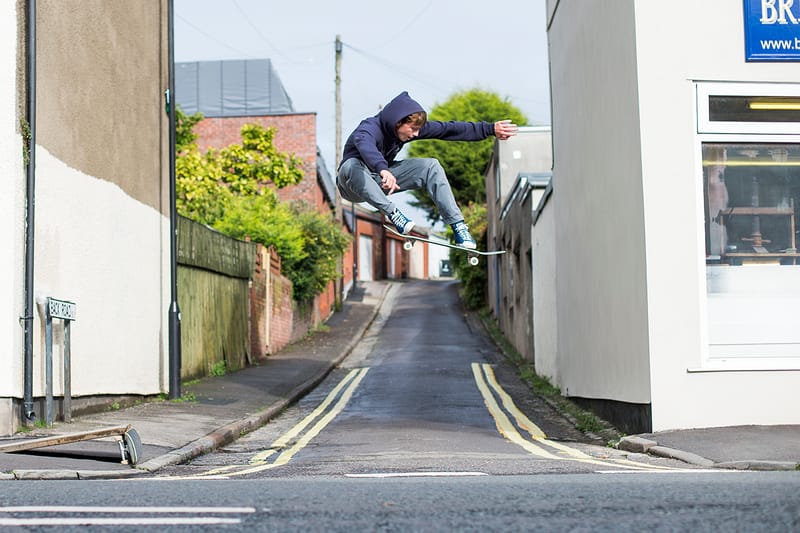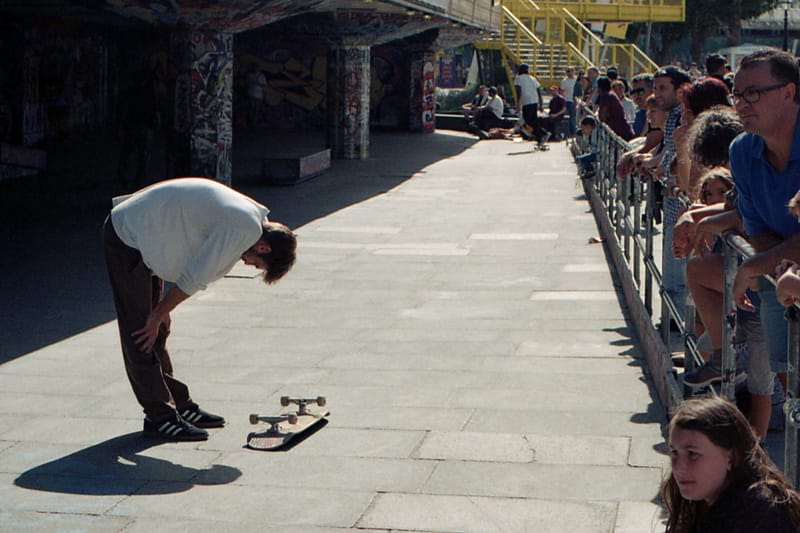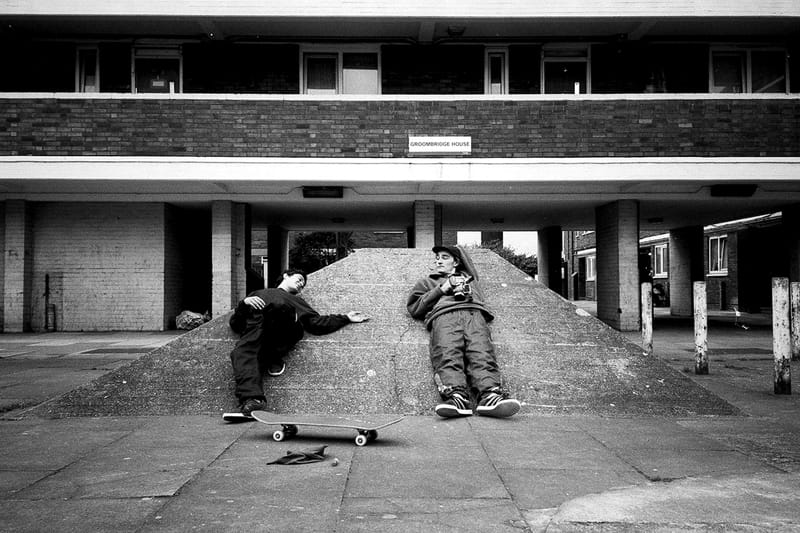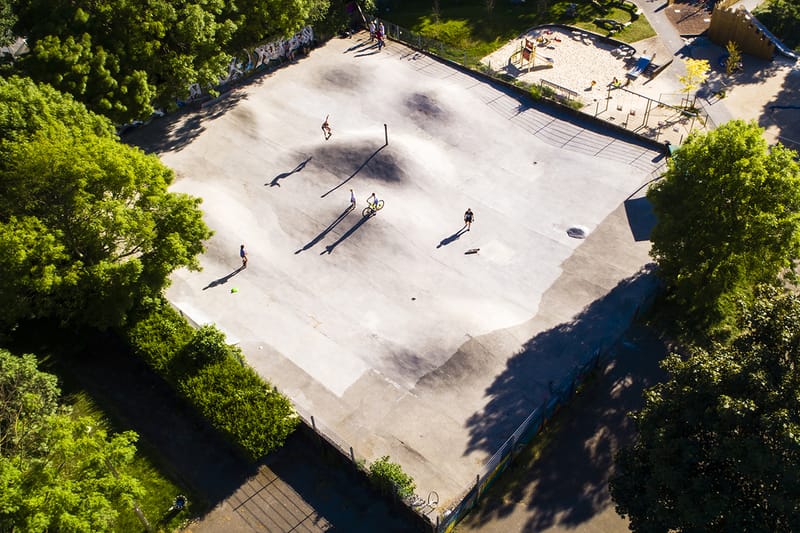After charting British skateboarding’s journey from the late ‘70s to the turn of the millennium in Part One, the second installment of our oral history of U.K. skateboarding looks at its modern era. Beginning with the cultural impact of Tony Hawk’s Pro-Skater, this was the period when the Southbank was saved and that Palace was born, placing the U.K. on the skateboarding map in a way that had never happened before.
Alongside that, skateboarding crossed into the mainstream to an unparalleled degree. On one hand, luxury houses from Lanvin to Louis Vuitton began looking to skateboarding for inspiration, while on the other skateparks were built up and down the country, and a new — more diverse — generation became involved in the sport. This is how British skateboarding moved from the rough world of street skating to an accessible hobby for millions.
“All of a sudden, people who didn’t skate were wearing Vans, wearing AirWalk, wearing Etnies. We were looking at them going, ‘where’s your board?’”
A New Millennium
Dave Mackey, founder of Lost Art: The Tony Hawk game came out around when the shop opened, and skateboarding went through this huge boom because people were playing the Tony Hawk game, not necessarily because they were aware of it from other aspects.
Winstan Whitter, filmmaker and director of Rollin’ Through the Decades: There had been a lull between 1987 and when the Tony Hawk PlayStation game released [in 1999]. Skateboarding went uphill again, it got a boost from the game. That bought back a massive interest, then the X Games evolved and it blew up even more. The Tony Hawk games kept increasing, so there was this massive rise in skateboarding. Since then, the interest has stayed.
Neil MacDonald, writer and archivist, Science Versus Life: I think that [Jackass star] Bam Margera has got more to do with it than people want to mention. He was a great skateboarder, and the company he skated for made great videos. He definitely pushed skateboarding into this early 2000s mainstream mess where everything was a lot less definible.
More regular people are going to see skateboarding on their TV and MySpace than they would on the street. That’s where they’re going to be getting their influence from. It wasn’t the case that it was necessarily growing all that organically. It was something that certainly nudged by what was happening in the States
Whitter: We were young, so we could be a bit cliquey at times. All of a sudden, people who didn’t skate were wearing Vans, wearing AirWalk, wearing Etnies. We were looking at them going, “where’s your board?”
Reece Leung
MacDonald: In the 2000s, there was no real defining direction, there was nothing to get right into. It was all quite vague. There was so much sartorial confusion. I think with all the companies and the shops that were appearing, that’s when we got companies that were just warehouses full of quite shit skateboard products. But if a mum wanted to buy a skateboard for their kid and googled it, that’s what they’d find. That kind of diluted things a bit. You could see around that people were skating boards with uninspired graphics, people didn’t really care what they were wearing. People didn’t really know what to be into.
Dan Boulton, photographer and author of No Turning Back: Southbank 2005-2015: Over this period of time, the skaters became more and more uniformed. There was a point where everyone really all looked the same, wore the same brands. This didn’t last too long, though. I think there was a year or two where the Supreme influence was huge, then in the U.K. things got back to being a bit more in line with our own culture. It passed pretty quickly as a phase in UK skating, and I feel we are back to the roughness that we have always had over here.
Whitter: Loads more kids got into it, and that’s only a good thing. We realised that things were getting better for us, more decent skateparks were getting built, and the skateboard community was coming together to talk to the councils, telling them to rebuild parks and how to do it. It felt like we were actually being listened to finally, whereas it felt like we’d been knocking on doors for years and they hadn’t taken our advice.
“Things were getting better for us, more decent skateparks were getting built, and the skateboard community was coming together.”
The ‘Palace Era’
Marshall Taylor, director of Slam City Skates and co-founder of Palace: In 2007, Slam City was owned by Rough Trade Records — which is why it was upstairs and downstairs — and Rough Trade was about to go bankrupt. The only way they could save Rough Trade was that an investor was going to come in, he said “jettison this skateboard nonsense, we’re going to concentrate on the record shops.” Me and Gareth got together, we still didn’t have a lot of money, but we took the business for almost nothing. We were still only 25, we’d never run a proper business before and suddenly we took on all this debt.
MacDonald: The decade that Blueprint ended and Palace began completely reversed UK skateboarding. It recontextualised everything, it was great. There had been board companies coming and going, but they were all either hippies with a picture of a tree or the heavy metal guys with a skull on their board. Palace was a real-person thing, and it was quite noticeably so.
Taylor: We just ran with it, we knew that scene. Gareth had worked at Slam on Saturdays and Sundays. We were running Slam for a few years and we managed to get it breaking even. The Nike SB Dunk hype began around then, and that allowed us to get the business to a point where it wasn’t losing lots of money like it was historically. That’s also how we met Lev [Tanju, Palace founder], he was also an employee at Slam.
Alex Ramsell
MacDonald: Palace wasn’t doing the standard skateboard thing that everybody had done. Blueprint had finished off by just doing the absolute standard skateboard thing — getting an American on, the videos were starting to look like U.S. videos — and it just felt like a bit of a disappointment that Blueprint were looking at the States having done such a good job as a U.K. company. But Palace just felt so British. Palace succeeds because of who those people are. It’s just good people, and that was clear at the beginning.
Boulton: It’s incredible how big Palace became. I remember Lev selling boards and T-shirts out of a carrier bag at Southbank. Then, boom. Palace is huge. I love it.
Helena Long, professional skateboarder and consultant curator of No Comply: Skateboarding has always gone through peaks and troughs and trends, and now it’s on this massive high. When I started,there weren’t as many people doing it and you could look at someone with some skate shoes on and know they skate for sure. Now, people wear skate brands but they don’t skate. It’s helped support the scene, in that all these skateboard brands can afford to pay people to skate, to represent the brand, go on trips and do their thing. There have been more opportunities to do what I’ve personally always enjoyed to do, travelling with skateboarding. And now it’s supported by sponsors and brands.
“Palace wasn’t doing the standard skateboard thing that everybody had done. Palace just felt so British.”
Southbank Starts a Movement
Iain Borden, historian and author of Skateboarding, Space and the City: When the controversy over the undercroft at the Southbank Center took place, something like 150,000 people signed the petition that Long Live Southbank raised to keep skateboarding there. You can read that in a number of ways. One is that 150,000 people wanted to protect skateboarding, and I think they did, but I think what they were doing as well was answering the question of what do we value in our cities today? What do we want our cities to be like?
Whitter: Southbank is a really important space for all of the generations that have come through to now, and all of the generations that will come in the future. That’s why it was so important to fight to save it. We finally got to a place where the future is agreed on paper. We have a bit more certainty, we don’t have to worry about them saying it’s going to be knocked down or turned into shops. It’s been agreed that it is a place to skate.
Long Live Southbank has made a massive difference and I’m sure it will continue to. Our two-year battle to fight to save that spot has been researched and lectured about. It is in academia, it’s become somewhere like Love Park [in Philadelphia] or Embarcadero in San Francisco, how those places got taken away and how people fought to save it. Southbank is one of the greatest examples, it’s a space that was found by skaters who managed to save it from consumerism.
George Booth-Cole
Boulton: By around 2015, skaters began to take control of the space [Southbank]. Long Live Southbank did an incredible job of saving the Southbank as a skate spot, and also making and continuing to make improvements. They also show a new generation what can be done by getting involved and working hard. In turn, this has influenced and mobilized skaters all over the U.K. to make demands of local councils in getting better facilities or building DIY projects.
Jenna Selby, photographer and founder of Rogue Skateboards: There was a generation of metal parks that were absolutely rubbish, people were making a whole load of money out of that. It wasn’t thought through, whereas now councils will have consultations and actually listen to BMX, skateboarders, scooters, and take it on board. Rather than spend £250,000 on a useless park, they’ll listen and get it right, and that’s been absolutely brilliant.
MacDonald: It’s also from councils competing with neighbouring councils and getting around the UK. People writing to the local newspaper, “I was in the neighbouring area and there’s a state of the art skateboard facility. Why don’t we have one?” All the mums are up in arms about it, and then they get one. And then the next council area up from them gets one.
Selby: The facilities are amazing now. I used to travel all over but now we’ve got three parks within 20 minutes of where we live. I almost feel like I don’t need to go anywhere else. Obviously we still don’t have world class facilities, but we’re heading in the right direction.
“Long Live Southbank did an incredible job of saving the Southbank as a skate spot, they also show a new generation what can be done by getting involved and working hard.”
Skate Opens Up
Selby: When I started in 1998, I didn’t know any other girls or women who skated. They didn’t mean anything malicious by it, but people would stop and stare because they weren’t used to seeing a girl in a skate park. But, being that person, it could be quite a daunting experience. I was quite shy at the time, so I’d just go off and do my thing. Over the years, I got to know a few more but it was always over a handful of women involved.
Long: It didn’t cross my mind that I was the only girl with my group of friends at the time. About a year into skateboarding, I met another girl who skated. We exchanged phone numbers, had a skate and I remember thinking “maybe more than just us exist.”
She then introduced me to a girl skate jam that used to happen once a year in St Albans, and then there were about 20 girls in a room and that was the entirety of the U.K. skate scene at the time. They’d come from far and wide, Scotland, up north, all the way down south. It was quite special because it was something I’d never really thought about. It was quite unique.
Jørn Tomter
Selby: Guys were getting coverage for their skating, but we had to have some “purpose” behind it which was always health and fitness, because they couldn’t put a story behind why women were skating. That was what spurred me on to start Rogue [the first all-female UK skate team]. I felt like women should be receiving coverage about their skateboarding, not focused on health and fitness.The idea to promote women in the right way.
When I was first photographing female skateboarding and trying to push it into the mainstream magazines it was really difficult to get any coverage for women. They’d only cover the same two women all the time. They only wanted to cover sponsored people, but they wouldn’t get sponsored until they got coverage. You couldn’t win.
Boulton: The biggest and most impressive thing to happen is women and girls getting into skating. When I shot this book it was incredibly rare to see a female skater, now it’s becoming so commonplace. It really is amazing to see this developing, and also I’m looking forward to seeing how it feeds back into the culture.
MacDonald: I think women are feeling more comfortable being able to skateboard because there are way more skateparks now. There’s somewhere you can go and meet other people, rather than having to go to the sketchy street spot or the vert ramp, there’s somewhere in between.
Borden: The skateparks and the way that skate culture has become more complex over the last 10 years just welcomes more people into skateboarding. Its not just hardcore street skaters any more. That’s still an incredibly important and valuable and central bit of skateboarding, but it’s not the only bit. Due to the return of skateparks and other factors, what you now see is people aged from five to 60, of every gender, sexual orientation, ethnicity, body shape that you can imagine. It’s become much more diverse and I think the skate parks have had quite a lot to do with that.
“The biggest change I’ve seen is that it’s become a lot more accessible to different communities, and a lot more inclusive.”
Long: I personally think [skateparks] have helped massively with those who are from somewhere in the U.K. that may not have existing facilities. But I think sometimes skateparks can appear as quite intimidating places and street skating has always existed pre-parks. I think a lot of new skaters and communities find safe, skateable spaces there too.
Selby: Facebook started it, but Instagram has been the big thing, with people posting their own videos, photos. That led to platforms like Girlskateuk.
Long: I’ve always talked about how social media has played a massive part in making it more accessible. It’s a platform where everyone can see others starting out, people find confidence in seeing someone else starting to skate, especially women or people from another smaller community within skateboarding. That helps to give confidence and encourage others to take it up, which is why there’s been this boom in it. The biggest change I’ve seen is that it’s become a lot more accessible to different communities, and a lot more inclusive.
Rich West
Selby: Love or hate the Olympics, it made a massive change for women’s skateboarding. The X Games didn’t take women seriously, you’d have amazing prize money for the guys and women would get a watch or $100 USD or something. As soon as the Olympics came along and said “you have to make it a gender-equal sport,” people like the X Games realized they had to give equal prize money, they had to look at women differently. We’re not this added appendage to skateboarding. People do it regardless of gender, they just do it because they love it.
Tory Turk, curator of No Comply: It’s many things to many people. It can be underground and counter culture to some people, but it can also be mainstream and accessible to the masses. It can have many different meanings. It’s not just acceptable, accessible for every single person everywhere you go, but it’s pretty mainstream now.
Source: Read Full Article







